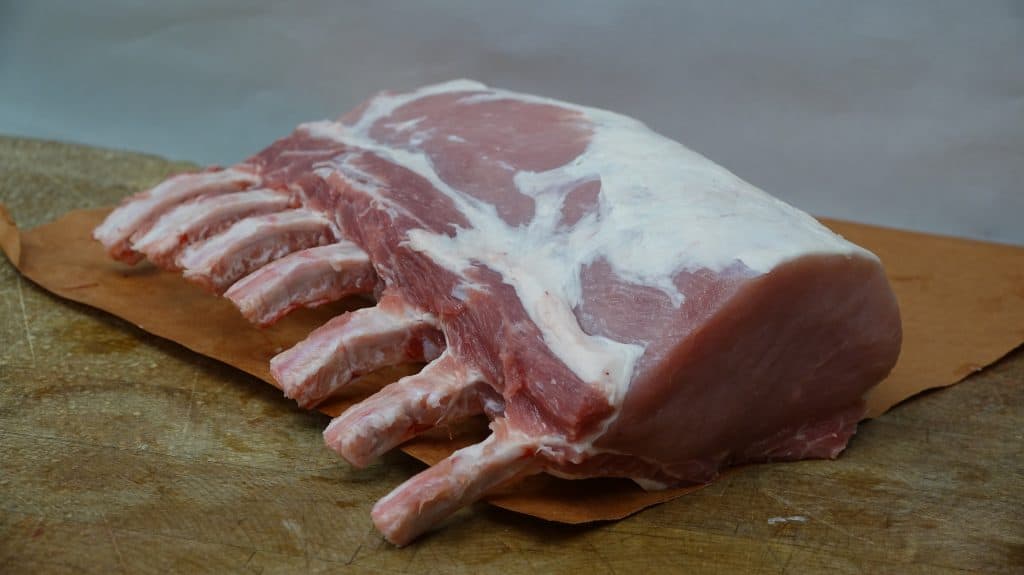Pork ribs are a culinary masterpiece, a tantalizing blend of succulent meat and irresistibly crispy skin that has tantalized taste buds for centuries. Yet, mastering the art of cooking a perfect rack of ribs is a quest that demands patience, precision, and an understanding of the delicate dance between heat and seasoning. In this comprehensive guide, we embark on this gastronomic adventure, unraveling the secrets of a mouthwatering rack of pork that will leave you craving for more.

Image: homeplusexpress.com
As we delve into the history of pork ribs, we find their origins intertwined with the culinary traditions of countless civilizations. From ancient feasts where whole pigs were roasted over open flames to the smoky barbecue pits of the American South, ribs have always been a symbol of celebration and culinary ingenuity.
Unveiling the Anatomy of a Rack of Pork
A rack of pork, also known as a baby back rib rack, is a section of the pig’s ribcage that typically consists of 10 to 12 ribs. These ribs are characterized by their tender meat and a delicate layer of fat that contributes to their rich flavor. Understanding the anatomy of a rack of pork is crucial for choosing the right cut and ensuring even cooking.
Selecting the Perfect Rack
Choosing a high-quality rack of ribs is essential for achieving a succulent and satisfying meal. Look for racks with a consistent reddish-pink color, evenly distributed fat, and minimal bone exposure. Avoid racks with excessive marbling, as too much fat can lead to a greasy dish.
Preparation Techniques: Unveiling the Secrets
Before cooking your ribs, it’s essential to prepare them properly. Start by removing the membrane from the back of the ribs. This tough layer can prevent the ribs from absorbing flavor and becoming tender. Using a sharp knife or the tip of a spoon, carefully separate the membrane from the bones and peel it away.
Next, season the ribs generously with a blend of salt, pepper, and your favorite spices. Let the ribs rest for at least 30 minutes, allowing the seasonings to penetrate deep into the meat.

Image: vincentsmeatmarket.com
Cooking Methods: The Art of Heat and Time
There are various cooking methods available for pork ribs, each offering its unique flavor profile and texture. Whether you prefer the smoky allure of grilling, the tender embrace of braising, or the convenience of roasting, understanding these methods will empower you to choose the technique that best suits your taste buds.
Grilling: Grilling imparts a smoky, charred flavor to ribs, creating a crispy exterior while maintaining a juicy interior. To grill pork ribs, preheat your grill to medium-high heat and sear the ribs for a few minutes per side. Reduce the heat to low, wrap the ribs in aluminum foil, and cook for 2 to 3 hours, or until tender.
Braising: Braising involves slow-cooking ribs in a flavorful liquid, resulting in fall-off-the-bone tenderness. In a large Dutch oven or roasting pan, sauté aromatics such as onions, garlic, and carrots. Add the ribs and cover them with a flavorful liquid, such as beer, barbecue sauce, or stock. Cook over low heat for 2 to 3 hours, or until the meat is easily pulled from the bones.
Roasting: Roasting ribs in the oven is a convenient and versatile method that allows for precise temperature control. Preheat your oven to 325°F (160°C). Season the ribs and place them on a wire rack set over a baking sheet. Roast for 2 to 2 ½ hours, or until the internal temperature reaches 145°F (63°C) as measured by a meat thermometer.
Glazing and Saucing: The Finishing Touches of Flavor
Glazing or saucing your ribs during the last hour of cooking adds an extra layer of flavor and ensures a glossy, caramelized finish. Choose a glaze or sauce that complements the seasonings you used earlier. Apply the glaze or sauce evenly to the ribs using a brush and return them to the oven or grill. Continue cooking until the glaze or sauce thickens and sets, about 15 to 20 minutes.
Resting and Serving: The Patience of Perfection
Once the ribs are cooked, it’s essential to let them rest for at least 30 minutes before slicing and serving. This allows the juices to redistribute, resulting in tender and succulent meat. Slice the ribs between the bones and serve them immediately with your favorite dipping sauce or alongside a selection of sides such as coleslaw, potato salad, or grilled vegetables.
How To Cook A Rack Of Pork
Conclusion: A Journey Well Traveled, a Feast Well Earned
Mastering the art of cooking a rack of pork is a culinary adventure that rewards the patient with succulent, fall-off-the-bone perfection. From carefully selecting the ribs to meticulously preparing and cooking them, each step contributes to the symphony of flavors that will dance on your palate. Whether you embrace the smoky allure of grilling, the gentle warmth of braising, or the convenience of roasting, the journey to a divine rack of pork is one that will leave you craving for more. So, don your apron, gather your ingredients, and embark on this culinary expedition, for the rewards of a perfectly cooked rack of ribs are worth every ounce of effort.